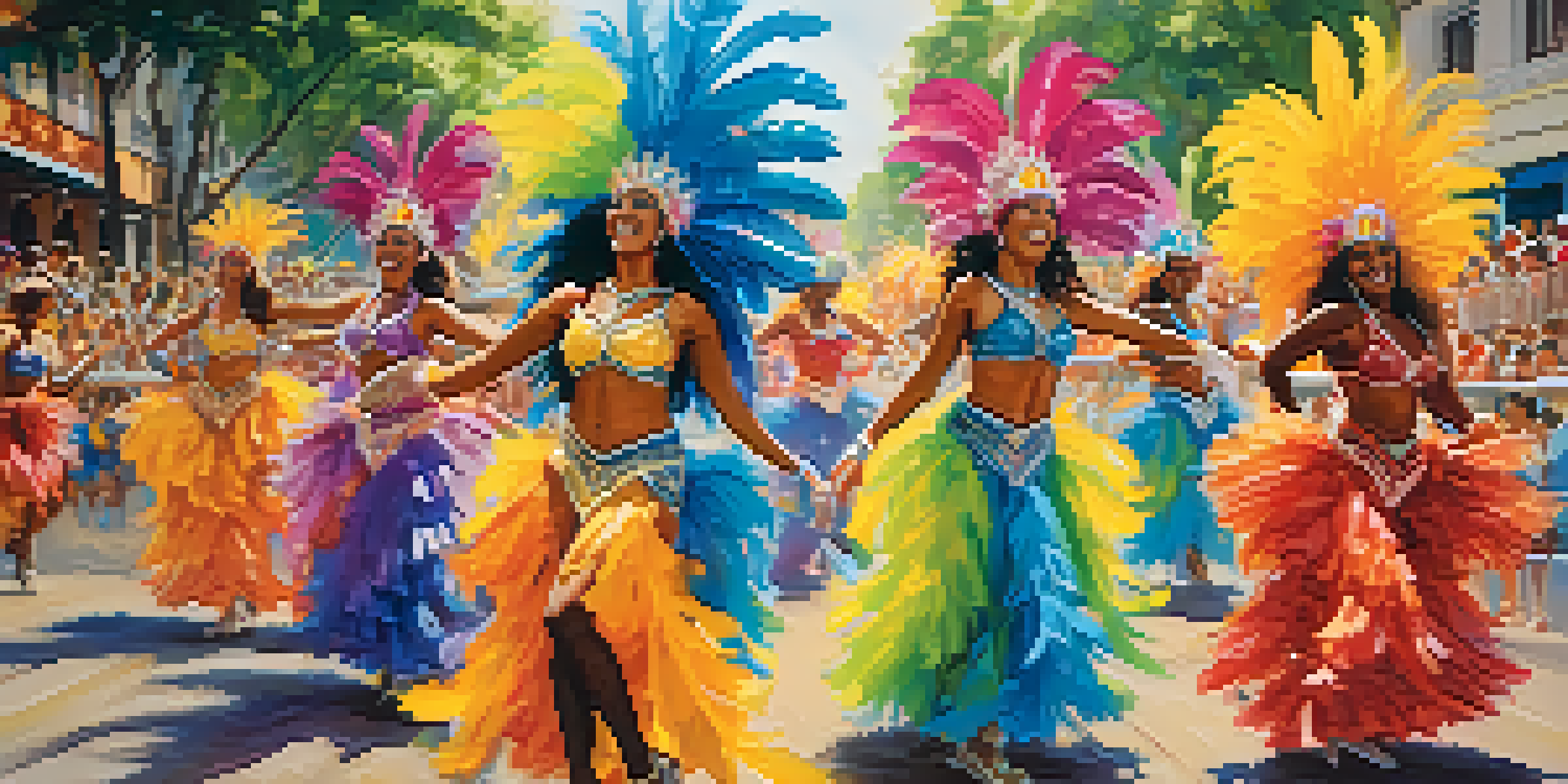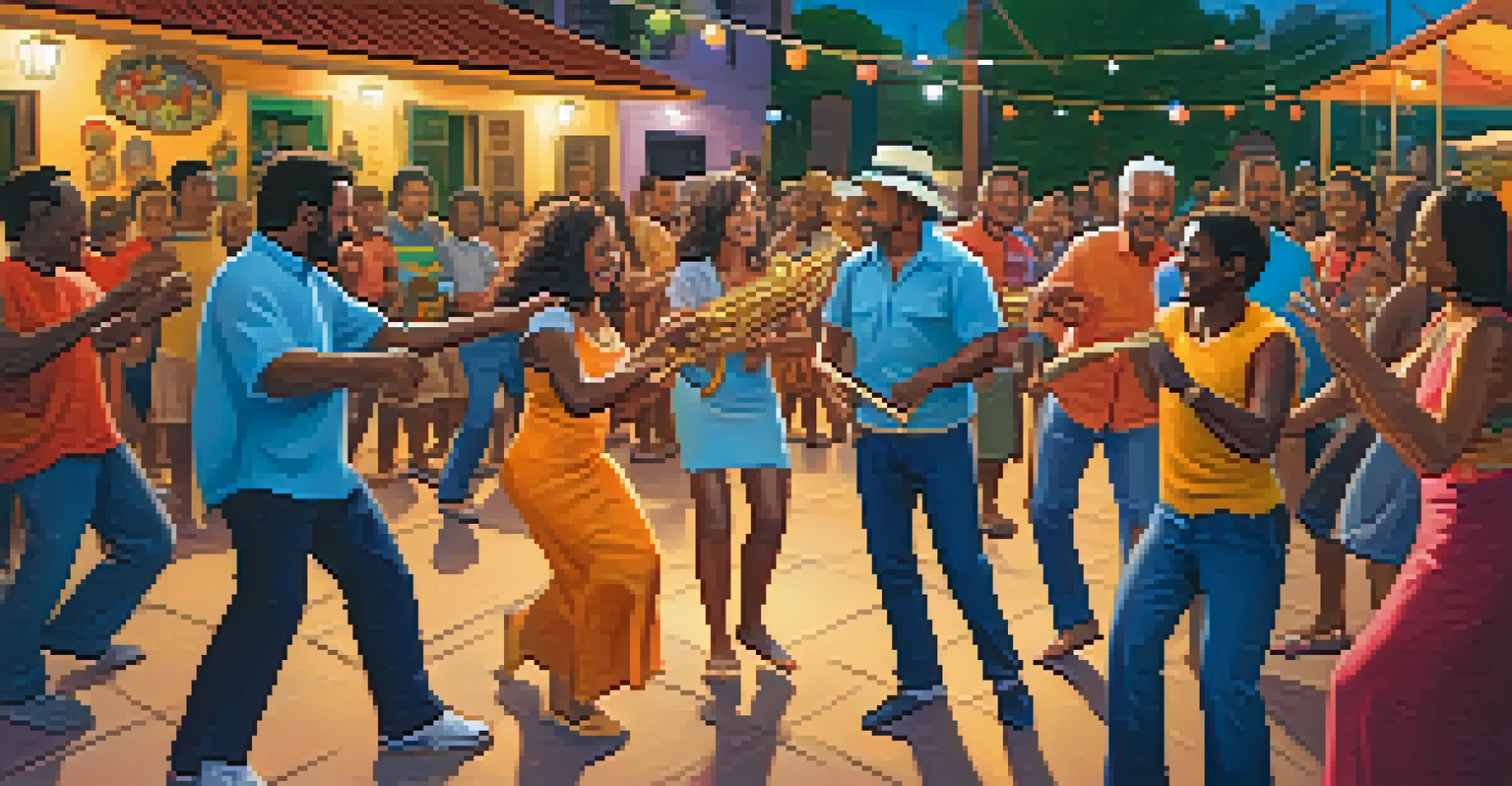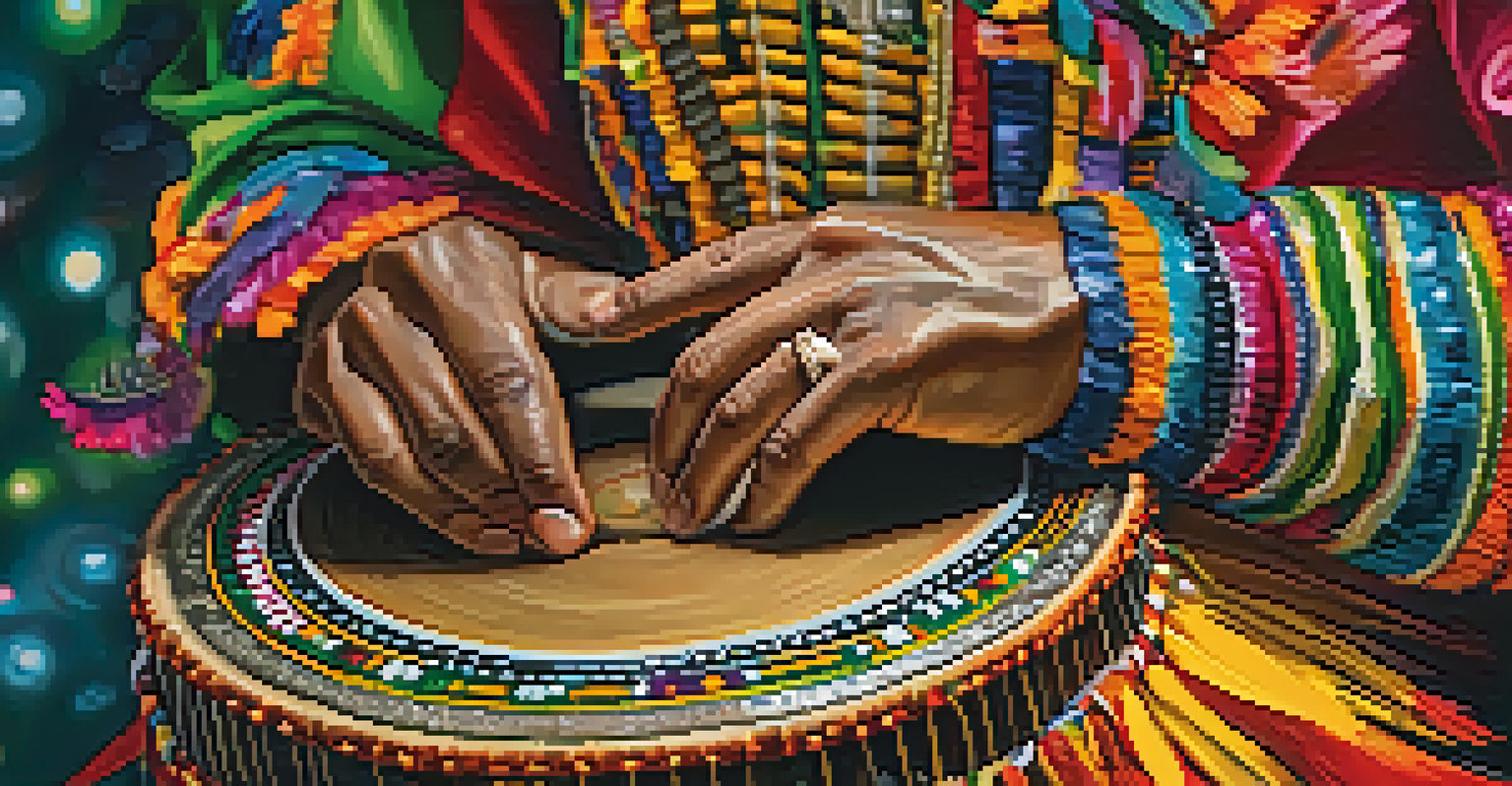Cultural Significance of Samba in Brazilian Festival Celebrations

Understanding Samba: More Than Just Dance
Samba is more than just a lively dance; it's a rich cultural expression that embodies the spirit of Brazil. Originating in the Afro-Brazilian communities, this rhythmic art form captures the essence of joy, community, and resilience. It tells stories of love, struggle, and celebration, making it a vital part of Brazilian identity.
Samba is a dance that, like life, is full of rhythm and movement, connecting us to our roots and to each other.
Through its infectious beats and colorful movements, Samba has evolved over the years while staying true to its roots. The music often features instruments like the tamborim and the surdo, creating a sound that resonates deeply within the cultural fabric of Brazil. Each step taken in Samba is not just choreography, but a connection to history and heritage.
As we delve deeper into the significance of Samba, we discover how it plays a central role in festivities, especially during Carnival. The dance unites people from all walks of life, fostering a sense of togetherness that transcends social barriers, making it a powerful symbol of Brazilian culture.
Samba's Role in Carnival Celebrations
Carnival is perhaps the most famous festival in Brazil, and Samba is its heartbeat. Every year, millions flock to the streets to witness elaborate parades, vibrant costumes, and, of course, electrifying Samba performances. The festival serves as a platform for schools of Samba to showcase their artistry, creativity, and cultural narratives.

During Carnival, Samba becomes a form of storytelling, where each school presents a theme that reflects social issues, historical events, or Brazilian folklore. The performances are meticulously choreographed and often involve hundreds of dancers, musicians, and artists working together in perfect harmony. This collaboration amplifies the sense of community and pride among participants.
Samba: A Cultural Beacon of Brazil
Samba embodies Brazil's spirit, representing joy, community, and resilience through its vibrant dance and music.
Moreover, the energy of Carnival is contagious. As locals and tourists join in the festivities, they become part of something larger than themselves. Samba, with its lively rhythms and inviting nature, encourages everyone to dance, laugh, and celebrate life, reinforcing its significance as a cultural touchstone.
The Evolution of Samba Through History
Samba's journey is a testament to Brazil's diverse cultural landscape. Emerging in the early 20th century, it combined elements from African rhythms, Portuguese melodies, and indigenous sounds. This fusion not only reflects the country's complex history but also highlights the resilience and creativity of its people.
In the heart of every Samba beat lies the story of a people, their struggles, and their triumphs.
Over the decades, Samba has branched into various styles, including Samba de Gafieira and Pagode, each adding its unique flair while maintaining the core essence of the dance. This evolution showcases how Samba has adapted to contemporary influences while still honoring traditional roots, keeping the culture alive and relevant.
Today, Samba is celebrated worldwide, transcending geographical boundaries and inspiring countless artists and dancers. Its evolution is a reminder of the importance of cultural preservation, ensuring that the stories and traditions of the past continue to inspire future generations.
Samba as a Symbol of Resistance and Identity
For many Brazilians, Samba is not just a dance; it's a powerful symbol of resistance and identity. Rooted in the struggles of Afro-Brazilian communities, it emerged as a means of expressing their joys, sorrows, and aspirations. Samba provided an avenue for marginalized voices to be heard and celebrated.
During times of political upheaval, Samba became a form of protest, with lyrics addressing social injustices and advocating for change. This aspect of Samba highlights its role in fostering a sense of belonging and empowerment among those who identify with its rhythms and messages. It unites people in their shared experiences and collective hopes.
Carnival: Samba's Grand Stage
During Carnival, Samba serves as a powerful form of storytelling, uniting diverse communities in celebration and creativity.
In modern Brazil, the spirit of resistance continues through Samba, as artists use it to challenge societal norms and address contemporary issues. This ongoing dialogue emphasizes the dance's significance as a living, breathing reflection of Brazilian culture, ensuring that it remains relevant in today's world.
Community and Unity Through Samba
One of the most beautiful aspects of Samba is its ability to bring people together. In neighborhoods across Brazil, Samba circles, known as 'roda de samba,' create spaces for individuals to connect, share stories, and celebrate. These gatherings foster a sense of community and belonging, reminding participants of the power of togetherness.
In these circles, everyone is welcome, regardless of age or background. The infectious rhythms invite passersby to join in, creating an inclusive atmosphere where cultural exchange thrives. This communal spirit is vital, especially in a country as diverse as Brazil, where various cultures converge and coexist harmoniously.
In essence, Samba serves as a bridge that connects different communities, creating a shared cultural experience. Through dance, music, and laughter, Samba reinforces the idea that unity is at the heart of Brazilian culture, making it a cherished element of festival celebrations.
The Global Impact of Samba Culture
Samba's influence extends far beyond Brazil's borders, captivating audiences worldwide. As global interest in Brazilian culture rises, Samba has found its way into dance studios, music festivals, and cultural events around the globe. This international appreciation showcases the universal appeal of Samba's vibrant rhythms and expressive movements.
Artists from various backgrounds have embraced Samba, infusing it with their unique styles and interpretations. This cross-cultural exchange not only enriches the dance but also fosters a deeper understanding of Brazilian culture. Samba has become a cultural ambassador, sparking curiosity and dialogue among diverse communities.
Samba's Global Influence and Legacy
Samba has transcended borders, captivating global audiences and fostering cultural exchange while facing challenges to its traditional roots.
Moreover, the globalization of Samba serves as a reminder of the importance of cultural exchange. It encourages individuals to explore and celebrate differences while finding common ground through music and dance. Samba's global journey is a testament to the power of art in uniting people across cultures.
Preserving Samba: Challenges and Opportunities
While Samba thrives in festivals and celebrations, it faces challenges that threaten its traditional roots. Urbanization, commercialization, and the influence of modern music genres can dilute its cultural significance. As Samba evolves, it's crucial to strike a balance between innovation and preserving its authentic essence.
Community organizations and cultural institutions play a vital role in safeguarding Samba's heritage. By promoting workshops, performances, and educational programs, they ensure that future generations understand and appreciate the dance's history and significance. These efforts foster a sense of pride and ownership within communities.

Embracing technology and social media can also present new opportunities for Samba. Online platforms allow artists to reach wider audiences and share their passion for the dance. By leveraging these tools, Samba can continue to flourish, adapting to contemporary trends while staying rooted in its rich cultural legacy.